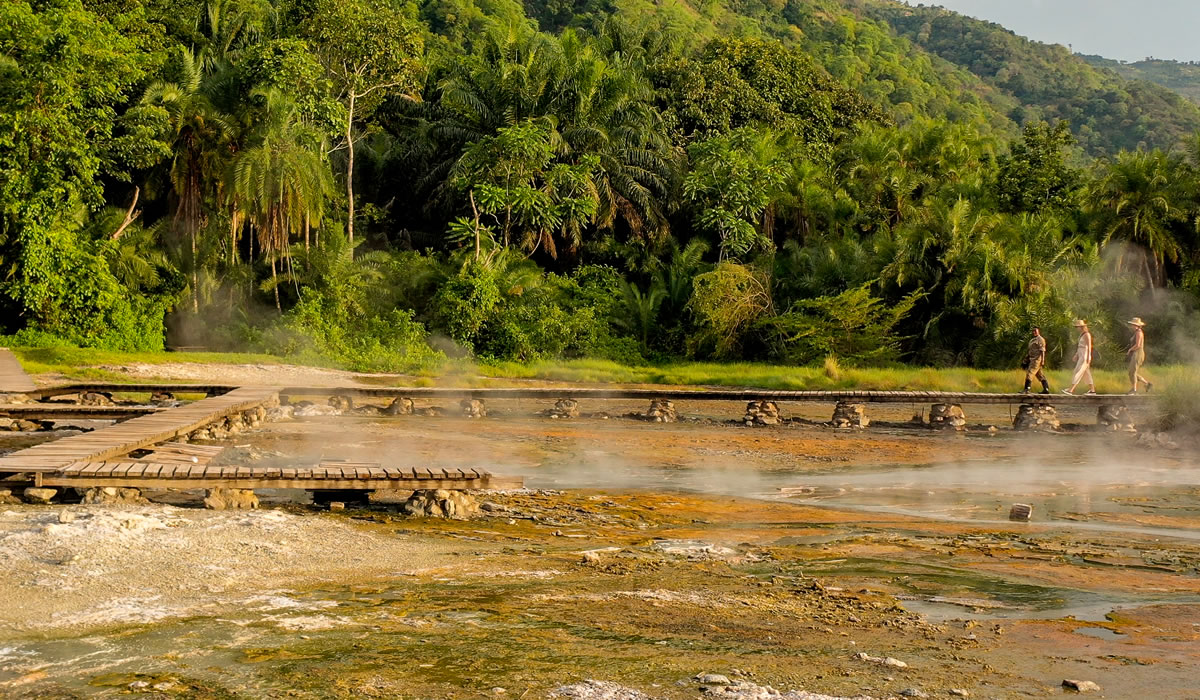Semuliki National Park, located in western Uganda along the border with the Democratic Republic of Congo, is one of the country’s most ecologically diverse and unique protected areas. Covering approximately 220 square kilometers, the park lies within the Albertine Rift and is known for its lowland tropical rainforest, hot springs, swamps, and a rich variety of flora and fauna. Semuliki offers travelers a rare opportunity to experience a lush, equatorial rainforest in East Africa, complete with primates, rare bird species, butterflies, and culturally significant communities. Its remote location, scenic beauty, and biodiversity make it a must-visit destination for nature enthusiasts, birdwatchers, and adventure travelers.

Landscapes and Ecosystems
Semuliki National Park is characterized by a combination of lowland tropical rainforest, swampy wetlands, and riverine systems. The park lies at an altitude of 670–1,000 meters above sea level, creating a warm and humid environment ideal for dense rainforest growth. The Semuliki River, which forms part of the park’s eastern boundary, along with several smaller streams and wetlands, supports a variety of aquatic life and provides essential water for the wildlife.
The park is particularly notable for its hot springs, which emerge from underground volcanic activity and create natural pools surrounded by lush vegetation. These hot springs, such as the famous Semliki Hot Springs, have cultural significance and attract both tourists and local communities.
The lowland rainforest ecosystem is home to tall trees, lianas, ferns, and a thick canopy that sustains a wide array of wildlife. Swampy areas and riverine forests support birds, amphibians, and invertebrates, while the park’s edges blend into grasslands and cultivated areas, creating a transition zone that adds to its ecological richness.
Wildlife in Semuliki National Park
Semuliki National Park is home to a remarkable variety of wildlife, including over 60 mammal species, more than 400 bird species, and countless reptiles, amphibians, and insects. Primates are a major attraction, with red-tailed monkeys, black-and-white colobus monkeys, olive baboons, and blue monkeys inhabiting the forested areas. Chimpanzees are occasionally sighted in the park, although they are more common in neighboring protected areas.
Birdwatchers will find Semuliki a paradise, with over 400 recorded species, including rare and endemic birds such as the African green broadbill, grey parrot, Ross’s turaco, and chocolate-backed kingfisher. Swamps and rivers attract species like the African fish eagle, herons, and various migratory birds. The park is also home to spectacular butterfly populations, with over 400 species, making it a world-class destination for butterfly enthusiasts.
Other mammals in Semuliki include forest elephants, bushbucks, duikers, giant forest hogs, and several species of small carnivores such as genets and civets. Elephants are occasionally seen near water sources, while forest antelopes and duikers provide fascinating sightings during guided walks. Reptiles, including snakes and lizards, inhabit the forest floor and riverbanks, adding to the park’s biodiversity.
Activities in Semuliki National Park
Semuliki National Park offers a variety of activities for travelers seeking wildlife encounters, cultural experiences, and nature-based adventures.
Guided Nature Walks
Guided walks through the rainforest allow visitors to observe wildlife up close and learn about the park’s ecology. Walks typically follow marked trails that pass through dense forest, swampy areas, and riverbanks. Experienced guides help visitors spot primates, birds, insects, and rare plant species while explaining the ecological importance of the rainforest. These walks are particularly rewarding in the early morning or late afternoon when wildlife activity is highest.
Birdwatching Tours
Birdwatching is one of the park’s most popular activities. Expert guides take visitors through the forest and along rivers and wetlands to spot endemic and migratory species. Birdwatching tours are ideal for photographers and nature enthusiasts, offering opportunities to see colorful sunbirds, turacos, hornbills, and raptors in their natural habitats.
Hot Springs Visits
Semuliki’s hot springs are both scenic and culturally significant. Visitors can relax in the natural pools while enjoying the surrounding rainforest scenery. Local communities use the springs for traditional ceremonies and bathing, and guided visits provide insight into the cultural and historical importance of these geothermal features.
Primate Watching
The park is home to several primate species, including red-tailed monkeys, black-and-white colobus monkeys, and blue monkeys. Guided primate-watching tours allow visitors to observe these animals as they forage, groom, and play in the forest canopy. Early morning treks often provide the best opportunities to see primates actively feeding and interacting.
Butterfly Watching
Semuliki National Park is renowned for its diverse butterfly population. Specialized butterfly tours help enthusiasts identify species such as the African emperor, blue pansy, and the exotic purple moon butterfly. Walks through flower-rich forest edges, riversides, and swamps are ideal for spotting these delicate insects.
Cultural Experiences
The park is located near communities of the Batwa, one of Uganda’s indigenous forest-dwelling peoples. Visitors can engage in cultural experiences, learning about traditional forest knowledge, hunting and gathering practices, music, and dance. Community tourism initiatives support the livelihoods of these communities while preserving cultural heritage and promoting responsible tourism.
Accommodation in Semuliki National Park
Accommodation options in Semuliki National Park cater to a range of budgets and preferences. Luxury lodges such as Semuliki Safari Lodge offer comfortable rooms, guided tours, and easy access to park activities. Mid-range accommodations include local guesthouses and eco-lodges that provide cozy stays with access to nature walks, birdwatching, and cultural tours. Budget travelers can find community-run campsites and basic lodges near the park entrance, offering affordable accommodation while supporting local initiatives.
Many lodges and camps are located close to the park’s main attractions, including the Semuliki River, hot springs, and forest trails, allowing convenient access for guided activities. Eco-friendly practices are emphasized to minimize environmental impact and promote sustainable tourism.
Best Time to Visit Semuliki National Park
The best time to visit Semuliki National Park is during the dry seasons from December to February and June to September. During these months, trails are more accessible, wildlife is easier to spot, and birdwatching is particularly productive.
The wet seasons, from March to May and October to November, bring lush greenery, active waterfalls, and abundant bird and butterfly activity. While some trails may be muddy and challenging, the wet season offers vibrant scenery and excellent opportunities for photography and nature observation. Visitors should be prepared with appropriate gear, including waterproof clothing and sturdy footwear, to navigate the rainforest terrain safely.
Getting to Semuliki National Park
Semuliki National Park is approximately 500 kilometers from Kampala. Travelers can reach the park by road, typically taking 8 to 10 hours via Fort Portal and Bundibugyo. The park’s remote location adds to its sense of adventure and wilderness. Bundibugyo town serves as the main gateway to the park, with lodges, guides, and park offices available to organize tours and activities.
For travelers combining Semuliki with other western Uganda destinations such as Queen Elizabeth National Park, Kibale Forest, or Rwenzori Mountains, the park provides an ideal extension for rainforest exploration, wildlife observation, and cultural experiences.
Conservation and Community Engagement
Semuliki National Park is managed by the Uganda Wildlife Authority, which focuses on protecting the rainforest ecosystem, conserving wildlife populations, and promoting sustainable tourism. Conservation efforts include anti-poaching patrols, forest restoration programs, and environmental education initiatives.
Community involvement is a crucial aspect of conservation in Semuliki. Local communities, particularly the Batwa, benefit from tourism through employment, guiding, cultural experiences, and handicraft sales. Supporting community-led tourism initiatives ensures that conservation efforts are sustainable, empowering local people while protecting the park’s unique biodiversity. Visitors are encouraged to engage responsibly with the environment and local communities, supporting practices that minimize ecological impact.
Semuliki National Park is a hidden gem in Uganda’s protected area network, offering a unique blend of tropical rainforest, hot springs, rare wildlife, and cultural experiences. From observing primates and rare birds to exploring geothermal hot springs, lush forests, and butterfly-rich habitats, visitors are guaranteed an immersive and memorable adventure.
The park’s ecological significance, combined with its remote location and cultural richness, makes Semuliki an ideal destination for travelers seeking an authentic nature experience. Whether birdwatching, hiking, engaging with local communities, or simply enjoying the serene rainforest, Semuliki National Park provides an unforgettable journey into one of East Africa’s most biodiverse and enchanting landscapes. By visiting, travelers contribute to conservation and community development, ensuring that this unique rainforest continues to thrive for future generations.

